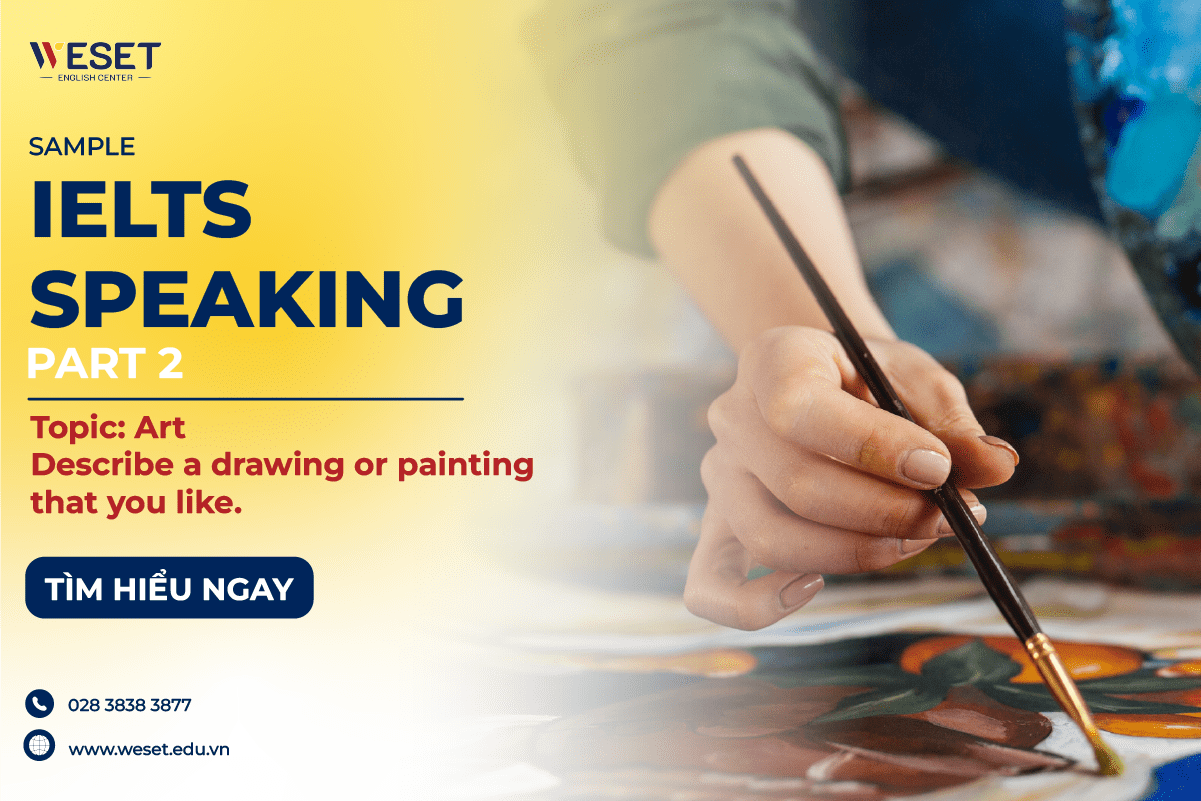Trang chủ Blog Bài thi IELTS mẫu IELTS Speaking: Describe a drawing or painting that you like
IELTS Speaking: Describe a drawing or painting that you like
- WESET
- Bài mẫu IELTS Sample Speaking, Bài thi IELTS mẫu, Blog
MỤC LỤC
Bạn sẽ xử lý như thế nào khi gặp chủ đề này trong IELTS Speaking: Describe a drawing or painting that you like. Tham khảo lời giải chi tiết từ WESET nhé!

Part 2: Describe a drawing or painting that you like.
IELTS Speaking 2:
Part 2: Describe a drawing or painting that you like
You should say:
- When/where did you see the painting?
- Who is the artist?
- What is the painting about?
- Explain why you find that painting impressive?
| When/where did you see the painting? | From my memories, I remember being entranced by a painting called The Fallen Angel, it was so beautiful and striking that it remains one of my favourite paintings. I was watching a video presenting iconic artworks of history, which included the painting that I had just told you about. This was the exact moment I set my eyes on The Fallen Angel for the first time. |
| Who is the artist? | The creator of this art piece is named Alexandre Cabanel. According to my own research, he was a well-known French artist and was most famous for his portraits. You might have even seen some of his christianity-inspired artworks before. |
| What is the painting about? | As a matter of fact, The Fallen Angel depicts Lucifer, who was an infamous figure in Christian mythology. He appears to be in a state of despair and anguish while looking at the sky above. The overall mood of the painting is one of sadness, loneliness, and perhaps even defiance. |
| Explain why you find that painting impressive? | Well, in terms of impressiveness, its visuals alone should be enough to awe anyone. From the colours to the composition, the artist masterfully painted an objectively beautiful picture. However, the most impactful trait to me is the painting’s ability to convey the angel’s emotional state. When looking at the artwork, I can get a sense of Lucifer’s despair and rage towards the heavens, which really left an impression on me. |
IELTS Speaking 2:
- What are the differences between painting and drawing?
The first and most obvious difference is the materials needed for the artwork. A painting primarily uses pigments that were mixed with a liquid medium, such as oil, acrylic or watercolour. Contrastingly, drawings mainly require dry media like pencils, charcoal or pastels. The second difference is the process of creating the pieces. Colour layering in painting is time-consuming as artists have to wait for each layer to dry before adding more. Whereas, drawing could be done swifter because it has less emphasis on layers, and focuses more on linework and shading.
- Why do some people keep a painting for a long time?
Beauty is certainly a reason to hold onto a painting. The act of hanging a piece of art in a space can enhance the charm of that area immensely. Additionally, a painting can even be the centrepiece of a room, helping to draw in the interest of guests. Another reason to keep a painting is personal connection. Perhaps some people find inspiration when looking at certain artworks or they find that they agree with the meaning of the art piece.
- How do young people share arts with others?
Social media is extremely common with the younger generations nowadays so it is not a surprise to see it being used as a vehicle to share arts. Sharing illustrations can be as simple as selecting what they want to show and clicking the post button. Some popular image-focused social media sites include Facebook, Instagram and Twitter.
- Do you think the objects we use in our daily lives should be beautifully designed?
Absolutely. Being surrounded by aesthetically pleasing things can have numerous positive impacts, one of which is the improvement of life quality. People tend to appreciate their surroundings and environment more when they are beautiful. Furthermore, it should encourage good mood simply by being looked at. One more beneficial effect is personal expression. The objects that a person finds appealing can be a reflection of personality, taste and value. For example, someone who prefers bold and colourful things might be extroverted and energetic, while people who love sombre tones could be more philosophical and introverted.
New words and phrases:
Part 2:
- Entranced (v): làm cho ai đó ngưỡng mộ và thích ai đó/cái gì đó rất nhiều, vì vậy họ dành toàn bộ sự chú ý của mình cho họ/cái đó
- Striking (adj): thú vị và đủ khác thường để thu hút sự chú ý
- Iconic (adj): là người hoặc vật nổi tiếng được mọi người ngưỡng mộ và coi là biểu tượng của một ý tưởng, lối sống cụ thể, v.v.
- Christianity-inspired (phrase): lấy cảm hứng từ Thiên Chúa Giáo
- Infamous (adj): nổi tiếng vì thứ xấu
- Despair (n): cảm giác đã mất hết hy vọng
- Anguish (n): đau đớn về thể xác hoặc tinh thần một cách nghiêm trọng
- Defiance (n): hành động công khai từ chối tuân theo ai đó/cái gì đó
- Awe (n): cảm giác rất ấn tượng về cái gì đó/ai đó
- Composition (n): cách thức các bộ phận khác nhau được tổ chức
- Impactful trait (phrase): đặc điểm có sức ảnh hưởng
Part 3:
- Pigments (n): bột màu được trộn với chất lỏng để tạo ra sơn
- Acrylic (n): chất acrylic
- Colour layering (phrase): xếp các lớp màu
- Swift (adj): làm gì đó nhanh chóng
- Emphasis on (phrase): nhấn mạnh vào
- Linework and shading (phrase): đường nét và đổ bóng
- Centrepiece (n): thứ quan trọng nhất
- Aesthetically pleasing (phrase): thẩm mỹ đẹp
- Appealing (adj): hấp dẫn hoặc thú vị
- Sombre tones (phrase): tông màu u ám
- Philosophical (adj): liên quan đến triết học
Tham khảo các bài mẫu Sample Writing theo chủ đề khác:






